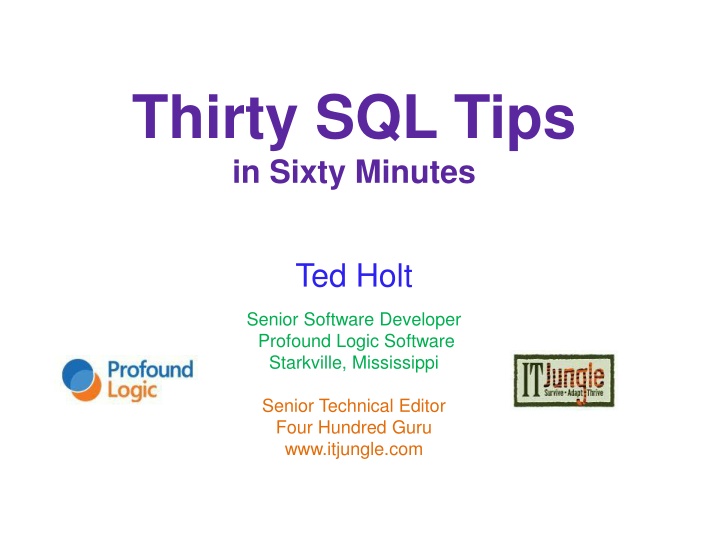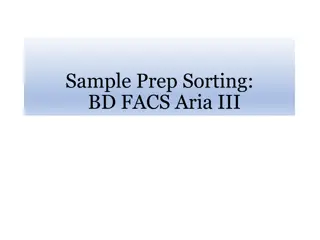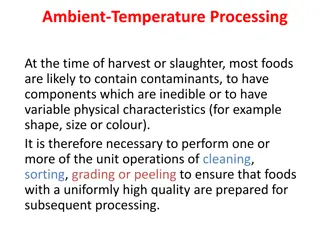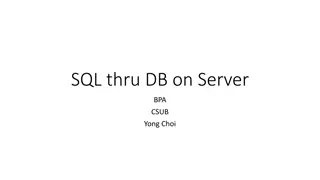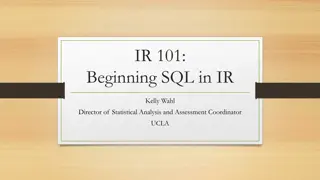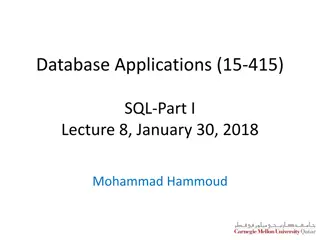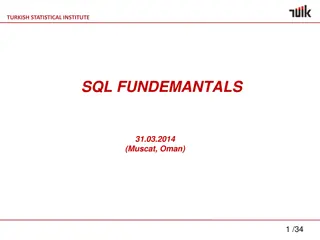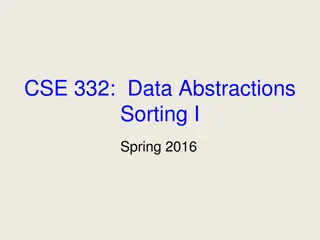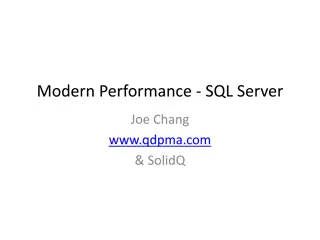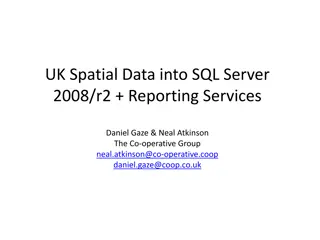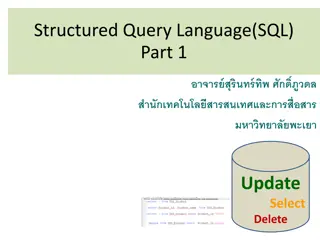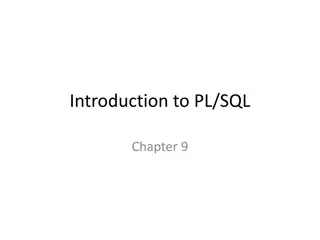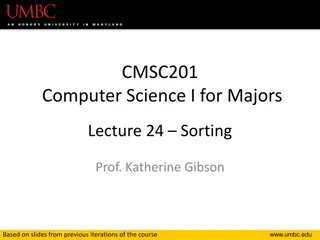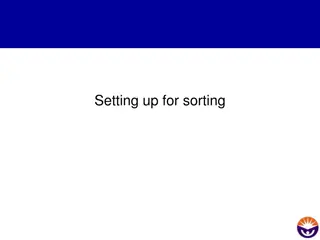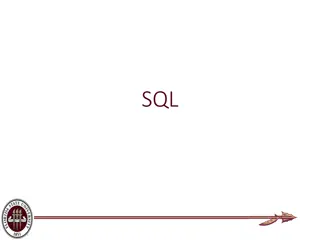SQL Tips to Enhance Data Sorting Techniques
Gain valuable insights into SQL tips for optimizing data sorting techniques. Learn how to utilize column numbers for efficient sorting, implement non-alphabetic sorting techniques, ignore case in sorts and comparisons, and access data in arrival sequence using the RRN function. These tips are designed to enhance your SQL query performance and productivity.
Download Presentation

Please find below an Image/Link to download the presentation.
The content on the website is provided AS IS for your information and personal use only. It may not be sold, licensed, or shared on other websites without obtaining consent from the author.If you encounter any issues during the download, it is possible that the publisher has removed the file from their server.
You are allowed to download the files provided on this website for personal or commercial use, subject to the condition that they are used lawfully. All files are the property of their respective owners.
The content on the website is provided AS IS for your information and personal use only. It may not be sold, licensed, or shared on other websites without obtaining consent from the author.
E N D
Presentation Transcript
Thirty SQL Tips in Sixty Minutes Ted Holt Senior Software Developer Profound Logic Software Starkville, Mississippi Senior Technical Editor Four Hundred Guru www.itjungle.com
1: Sort by Column Numbers You can use column numbers to indicate sort columns in the ORDER BY clause. This is especially helpful when sorting on calculated columns. select account, select account, ((curyear ((curyear - - prevyear) * 0.5) from saleshist order by 2, 1 from saleshist order by 2, 1 prevyear) * 0.5) http://publib.boulder.ibm.com/infocenter/iseries/v5r4/topic/db2/rbafzmstintsel.htm
2: Non-alphabetic Sorting Technique 1 Suppose you want data about Tennessee to sort ahead of all other states. Use a CASE construct in the ORDER BY clause. select * from sales select * from sales order by order by case when state = TN' case when state = TN' then 0 else 1 end, state then 0 else 1 end, state http://www.itjungle.com/fhg/fhg100604-story02.html
3: Non-alphabetic Sorting Technique 2 The following ORDER BY clause causes data for the Shipping department to sort ahead of data for the Receiving department. select * from trans select * from trans order by locate(dept, order by locate(dept, 'ACCOUNTING SHIPPING RECEIVING ') 'ACCOUNTING SHIPPING RECEIVING ') http://www.itjungle.com/fhg/fhg091306-story02.html
4: Two Ways to Ignore Case (1) Use national language support to ignore case in sorts and comparison. exec sql set option srtseq=*langidshr exec sql set option srtseq=*langidshr (2) Use case-conversion functions. select * from Customers select * from Customers order by upper(Name) order by upper(Name) http://www.itjungle.com/mgo/mgo111403-story01.html
5: Access in Arrival Sequence Use the RRN function to access a file by relative record number. select * from gltrans as select * from gltrans as s s where rrn( where rrn(s s) between 301 and 325 ) between 301 and 325 http://www.itjungle.com/fhg/fhg072705-story02.html http://www.itjungle.com/fhg/fhg022206-story02.html
The RRN function can be very useful for one-time maintenance tasks. I dont recommend using it for regular processing.
6: Access Multi-member Files SQL does not support multi-member database files. To access a member other than the first, create an alias. create alias mylib/pay2014 create alias mylib/pay2014 for mylib/payhist(year2014) for mylib/payhist(year2014) select * from mylib/pay2014 select * from mylib/pay2014 http://www.itjungle.com/guruo/mgo021302-story02.html
7: Create or Replace Use CREATE OR REPLACE to avoid having to drop an object before recreating it. create or replace view Names as create or replace view Names as select Name from people select Name from people http://www-01.ibm.com/support/knowledgecenter/ssw_ibm_i_72/sqlp/rbafycrtrepl.htm
8:Create or Replace Table If your release of SQL does not support CREATE OR REPLACE TABLE, you can fake it. begin begin declare continue handler declare continue handler for sqlexception for sqlexception begin end; begin end; drop table customers; drop table customers; end; end; create table customers . . . create table customers . . . http://www.itjungle.com/fhg/fhg012015-story01.html http://www-01.ibm.com/support/knowledgecenter/ssw_ibm_i_71/sqlp/rbafyreplacetable.htm
9: Clear a Table Finally! SQL can clear a physical file. truncate table daily truncate table daily is equivalent to CLRPFM DAILY CLRPFM DAILY http://www.itjungle.com/fhg/fhg062514-story01.html
10: Create TemporaryTables Use the DECLARE GLOBAL TEMPORARY TABLE command to create scratch tables in the QTEMP library. declare global temporary table t1 as declare global temporary table t1 as (select state, sum(baldue) as balancedue (select state, sum(baldue) as balancedue from qcustcdt group by state) from qcustcdt group by state) with data with data http://publib.boulder.ibm.com/infocenter/iseries/v5r4/topic/d b2/rbafzmstdgtt.htm
11: Keep Temporary Data The system clears temporary tables on commit unless you tell it not to. exec sql exec sql declare global temporary table Summary declare global temporary table Summary (state char(2), SumAmount dec(9,2)) (state char(2), SumAmount dec(9,2)) on commit preserve rows on commit preserve rows http://www-01.ibm.com/support/knowledgecenter/ssw_ibm_i_72/db2/rbafzdgtt.htm
12: Avoid Temporary Tables If possible, use a view or common table expression instead of a global temporary table. declare global temporary table STotal declare global temporary table STotal as (select state, sum(baldue) as Due as (select state, sum(baldue) as Due from qiws/qcustcdt from qiws/qcustcdt group by state) group by state) with data with replace with data with replace http://www.itjungle.com/fhg/fhg060215-story02.html
The same query with a common table expression. with with Stotal Stotal as (select state, sum(baldue) as Due (select state, sum(baldue) as Due from qiws/qcustcdt from qiws/qcustcdt group by state) group by state) as select a.*, b.* select a.*, b.* from qiws/qcustcdt as a from qiws/qcustcdt as a join join Stotal Stotal as b on a.state = b.state on a.state = b.state as b
13: Insert Multiple Rows Insert more than one row at a time using the VALUES clause of an INSERT statement. Separate rows with commas. INSERT INTO PLANTS VALUES INSERT INTO PLANTS VALUES (1,'Lost Angeles'),(2, 'New Yolk') (1,'Lost Angeles'),(2, 'New Yolk') http://www.itjungle.com/fhg/fhg010406-story02.html
14: Update one Table from Another Use the MERGE statement to update one table with data in another table. merge into items as tgt merge into items as tgt using (select ItemNumber, Price using (select ItemNumber, Price from NewPrices) as src from NewPrices) as src on tgt.ItemNumber = src.ItemNumber on tgt.ItemNumber = src.ItemNumber when matched then when matched then update set tgt.Price = src.Price update set tgt.Price = src.Price http://www.itjungle.com/fhg/fhg040313-story02.html
Item number Description DH-250 Doo-hickey, left-hand DH-300 Doo-hickey, right-hand TJ-117 Thimamajig, size 6 WC-321 Watchmacallit WI-101 Widget, 4-inch Cost 2.00 1.00 1.50 4.50 1.00 Price 3.00 1.75 3.00 7.00 1.75 Before Item number DH-250 DH-300 Price 3.50 2.00 merge into items as tgt merge into items as tgt using (select ItemNumber, Price using (select ItemNumber, Price from NewPrices) as src from NewPrices) as src on tgt.ItemNumber = src.ItemNumber on tgt.ItemNumber = src.ItemNumber when matched then when matched then update set tgt.Price = src.Price update set tgt.Price = src.Price Item number Description DH-250 Doo-hickey, left-hand DH-300 Doo-hickey, right-hand TJ-117 Thimamajig, size 6 WC-321 Watchmacallit WI-101 Widget, 4-inch Cost 2.00 1.00 1.50 4.50 1.00 Price 3.50 2.00 3.00 7.00 1.75 After
15: Use MERGE to Upsert Update data where it exists, add it where it doesn t. merge into items as tgt merge into items as tgt using (select * using (select * from ItemUpdate) as src from ItemUpdate) as src on tgt.ItemNumber = src.ItemNumber on tgt.ItemNumber = src.ItemNumber when matched then when matched then update set update set tgt.Description = src.Description, tgt.Description = src.Description, tgt.Cost = src.Cost, tgt.Cost = src.Cost, tgt.Price = src.Price tgt.Price = src.Price when not matched then when not matched then insert values insert values (src.ItemNumber, src.Description, (src.ItemNumber, src.Description, src.Cost, src.Price) src.Cost, src.Price) http://www.itjungle.com/fhg/fhg012715-story02.html
Item number Description DH-250 Doo-hickey, left-hand DH-300 Doo-hickey, right-hand TJ-117 Thimamajig, size 6 WC-321 Watchmacallit WI-101 Widget, 4-inch Cost 2.00 1.00 1.50 4.50 1.00 Price 3.00 1.75 3.00 7.00 1.75 Before Item number Description DH-100 Doo-hickey, universal WI-101 Widget, 4-inch Cost 2.50 1.50 Price 3.00 2.75 merge into items as tgt merge into items as tgt using (select * using (select * from ItemUpdate) as src from ItemUpdate) as src on tgt.ItemNumber = src.ItemNumber on tgt.ItemNumber = src.ItemNumber when matched then when matched then update set update set tgt.Description = src.Description, tgt.Description = src.Description, tgt.Cost = src.Cost, tgt.Cost = src.Cost, tgt.Price = src.Price when not matched then insert values when not matched then insert values (src.ItemNumber, src.Description, (src.ItemNumber, src.Description, src.Cost, src.Price) tgt.Price = src.Price src.Cost, src.Price) Item number Description DH-100 Doo-hickey, universal DH-250 Doo-hickey, left-hand DH-300 Doo-hickey, right-hand TJ-117 Thimamajig, size 6 WC-321 Watchmacallit WI-101 Widget, 4-inch Cost 2.50 2.00 1.00 1.50 4.50 1.50 Price 3.00 3.00 1.75 3.00 7.00 2.75 After
16: Row Value Expressions Simplify row selection by comparing rows of values, rather than single values, to one another. select * From Project Where select * From Project Where (PROJNO, ACTNO) = ('AD3100','10') (PROJNO, ACTNO) = ('AD3100','10')
Row value expressions are also great for joins. SELECT * SELECT * FROM cacmst a FROM cacmst a left outer join cinvp b left outer join cinvp b on (a.cmlocn,a.cmcont) = (b.silocn,b.sicont) on (a.cmlocn,a.cmcont) = (b.silocn,b.sicont) left outer join trudtp c left outer join trudtp c on (b.silocn,b.sicont,b.siitem,b.siseqn,b.silino) = on (b.silocn,b.sicont,b.siitem,b.siseqn,b.silino) = (c.tulocn,c.tucont,c.tuitem,c.tuseqn,c.tulino) (c.tulocn,c.tucont,c.tuitem,c.tuseqn,c.tulino) ORDER BY a.cmlocn, a.cmcont ORDER BY a.cmlocn, a.cmcont http://www.itjungle.com/fhg/fhg021015-story02.html http://www.itjungle.com/fhg/fhg100913-story02.html http://www.itjungle.com/fhg/fhg041410-story02.html http://www.itjungle.com/fhg/fhg041206-story01.html
17: Null Does Not Equal Null (and null does not not equal null) If you want to compare null to null, use IS [NOT] DISTINCT FROM. SELECT * FROM SomeTable SELECT * FROM SomeTable WHERE SomeField IS NOT DISTINCT FROM WHERE SomeField IS NOT DISTINCT FROM AnotherField AnotherField http://www.itjungle.com/fhg/fhg091405-story01.html
18: Wildcards in RPG The %SCAN BIF does not support wild cards, but SQL does. dcl dcl- -s Matched char(1); s Matched char(1); exec sql exec sql set :Matched = case set :Matched = case when :inSource like :inPattern when :inSource like :inPattern then '1' else '0' end; then '1' else '0' end; http://www.itjungle.com/fhg/fhg120314-story01.html http://www.itjungle.com/fhg/fhg011205-story02.html
If RPG doesn't have a BIF you need, use an SQL function. exec exec sql values hex(:Class) into :Token values hex(:Class) into :Token sql http://www.itjungle.com/mgo/mgo080803-story02.html http://www.itjungle.com/fhg/fhg012804-story04.html
19: Wildcards on Steroids Regular expressions allow more specific searches than wildcards do. select * from people as p select * from people as p where regexp_like(p.street, where regexp_like(p.street, '^1 '^1\ \d{2} .*Main') d{2} .*Main') http://http://www.itjungle.com/fhg/fhg051915-story01.html
20: Remove Extra Spaces in a String Replace two or more blanks with only one. (E.g., "Joe Smith" becomes "Joe Smith".) update mydata set name = replace( replace( replace(name, ' ','<>'),'><',''),'<>',' ') http://mullinsconsulting.com/bp11.htm http://www.itjungle.com/fhg/fhg101106-story02.html
Assume NAME is Joe Smith. (There are 12 blanks after Joe.) Joe Smith Joe<><><><><><><><><><><><>Smith Joe<>Smith Joe Smith Original string Last REPLACE Middle REPLACE First REPLACE
21:Easily Process Non-date Dates Use the FMTDATE function to convert numeric or alpha fields to manageable formats. select fmtdate(DueDate, cymd , iso select fmtdate(DueDate, cymd , iso- - ), . . . . . . from MfgOrders from MfgOrders ), http://www.itjungle.com/fhg/fhg050515-story02.html http://www.itjungle.com/fhg/fhg120209-story02.html http://www.itjungle.com/fhg/fhg081909-story02.html
Instead of this: substr( digits(dec(19000000+crdate,8,0)), 5, 2 ) || '/' || substr( digits(dec(19000000+crdate,8,0)), 5, 2 ) || '/' || substr( digits(dec(19000000+crdate,8,0)), 7, 2 ) || '/' || substr( digits(dec(19000000+crdate,8,0)), 7, 2 ) || '/' || substr( digits(dec(19000000+crdate,8,0)), 1, 4 ) substr( digits(dec(19000000+crdate,8,0)), 1, 4 ) Do this: fmtdate(CRDATE,'CYMD','MDYY/') fmtdate(CRDATE,'CYMD','MDYY/')
22: Unusual Rounding You don't have to round to the nearest power of ten. You can round to other whole numbers, or even to fractions. select dec( select dec( round(price * round(price * 4 4, 0)/ as Nearest_Qtr as Nearest_Qtr from PriceBook from PriceBook , 0)/4 4, 11, 2) , 11, 2) http://www.itjungle.com/fhg/fhg092105-story02.html
Multiply by the reciprocal of the number to which you are rounding. Divide by the reciprocal. In this example, multiply by four to round to the nearest one-fourth. Then divide by four. Example: Price Rounded ======= ======== 1.00 1.00 1.12 1.00 1.13 1.25 1.25 1.25 1.49 1.50 1.51 1.50
23: How Many Rows Did I Fetch? Use the SQLER3 or SQLERR(3) field to see how many rows were affected by the previous I/O operation (i.e., fetch, insert, update, delete). exec sql exec sql delete from PriceBook delete from PriceBook where PrcFlag = 'X'; where PrcFlag = 'X'; if SQLER3 > *zero; if SQLER3 > *zero; http://www.itjungle.com/fhg/fhg020404-story02.html
24: Load Data into IFS Files Use Qshell's db2 utility to place data into an IFS file. db2 "SELECT char(CUSNUM) || ', || LSTNAM || db2 "SELECT char(CUSNUM) || ', || LSTNAM || ', || char(baldue) from qiws.qcustcdt" ', || char(baldue) from qiws.qcustcdt" | sed | sed - -n '/,/p' >> custdata.csv n '/,/p' >> custdata.csv http://www.itjungle.com/fhg/fhg020205-story02.html
25: Generate DDL Don t convert physical files to DDL by hand! System i Navigator QSQGNDDL API QSYS2.GENERATE_SQL stored procedure Third-party utilities http://www.itjungle.com/mgo/mgo060502-story01.html http://www.itjungle.com/mgo/mgo061202-story02.html http://www.itjungle.com/fhg/fhg111214-printer01.html http://www.epi-software.com/convert_dds_to_sql.html
26:Use an SQL Formatter An SQL formatter can make your code easier to read. Set case of keywords, column names, functions, variables etc. Align similar parts of a statement. http://www.dpriver.com/pp/sqlformat.htm (Google sql formatter for more.)
An Inspirational Thought An Inspirational Thought from Ashley Phix 28.35 grams of prevention is worth 0.4536 kilograms of cure. 8/27/2024
27: Rule of Thumb 1 If you use GROUP BY, you probably want ORDER BY, too. SELECT state, COUNT(*), SUM(baldue) SELECT state, COUNT(*), SUM(baldue) FROM qiws.qcustcdt FROM qiws.qcustcdt GROUP by state GROUP by state ORDER BY state ORDER BY state http://www.itjungle.com/guruo/guruo112101.html
28: Rule of Thumb 2 Use a left outer join unless you have a reason to use some other type. SELECT a.cusnum, a.lstnam, a.init, SELECT a.cusnum, a.lstnam, a.init, a.city, b.statename a.city, b.statename FROM qcustcdt AS a FROM qcustcdt AS a LEFT JOIN states AS b LEFT JOIN states AS b ON a.state = b.abbr ON a.state = b.abbr
29: Rule of Thumb 3 Use UNION ALL, not UNION, by default. SELECT Customer, Item, ShipQty SELECT Customer, Item, ShipQty FROM CurrYear FROM CurrYear UNION ALL UNION ALL SELECT Customer, Item, ShipQty SELECT Customer, Item, ShipQty FROM PrevYear FROM PrevYear http://www.itjungle.com/fhg/fhg092607-story01.html
30: Rule of Thumb 4 Use correlation names to qualify, even when they re not required. select select c c.cusnum, .cusnum, c c.lstnam, c c.state, coalesce( .state, coalesce(s s.name,' ') from qcustcdt as from qcustcdt as c c left join states as left join states as s s on on c c.state = .state = s s.abbr .abbr .lstnam, c c.city, .name,' ') .city,
Improves readability. Helps avoid common errors. http://www.itjungle.com/fhg/fhg102407-story01.html http://www.itjungle.com/fhg/fhg031208-story02.html http://www.itjungle.com/fhg/fhg091515-story02.html
31: Remember Your Priorities select * from life where people > things
